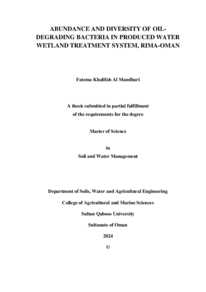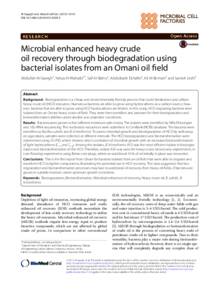وثيقة
Abundance and diversity of oil-degrading bacteria in produced water wetland treatment system, Rima-Oman.
المصدر
Master's thesis
عناوين أخرى
وفرة وتنوع البكتيريا المحللة للنفط في نظام معالجة الأراضي الرطبة للمياه المصاحبة للنفط، : موقع ريما- بسلطنة عمان
الدولة
Oman
مكان النشر
Muscat
الناشر
Sultan Qaboos University
ميلادي
2024
اللغة
الأنجليزية
نوع الرسالة الجامعية
Master's thesis
الملخص الإنجليزي
Produced water is excess water from oil production, which contains hydrocarbon residues
and other pollutants. One method that can be used to treat wastewater is the construction
of artificial wetlands. The Rima Water Treatment Project (Oman) is a constructed wetland
that was recently implemented to biologically treat produced water. In this study, the
abundance and diversity of oil-degrading bacteria across the wetland system were
evaluated and compared to water quality, as it progressed through four subsequent
terraces in three parallel tracks of the wetland. In addition, oil-degrading bacteria have
been isolated and characterized based on their ability to withstand different environmental
conditions. The chemical properties of the sample were measured, including the oil
content in water, pH, EC, total elemental composition, and hydrocarbon compounds,
using gas chromatography-mass spectrometry (GC-MS). Culturable bacteria were
enumerated using nutrient agar, Bushnell Haas mineral salt (BHMS) agar, and mineral
salt medium (MSM) as minimal media. Morphologically different bacteria were isolated
and tested for their ability to degrade crude oil using a MicroResp™ system. The strains
with the highest oil degradation rates were further tested for their ability to withstand high
ionic strengths, a broad range of pH, and their response to NPK fertilizers using growth
curve analysis. The strains were then tested for their ability to form biofilms. Microbial
diversity was assessed by 16S rRNA V4 gene sequencing in the Rima wetland system.
Our findings showed that the oil-in-water content decreased to less than 1 ppm at the end
of the wetland. In contrast, EC, pH, and minerals such as Na progressively increased as
they flowed through the four stages of the wetland. Most hydrocarbon compounds
decreased as they progressed through the system. Moreover, the bacterial enumeration
progressively decreased, being highest in the first terrace. Interestingly, there was also a
significant difference in bacterial enumeration between the three parallel tracks. Oildegrading bacteria were more abundant in the first two terraces of the wetland and in the
second and third tracks. The isolated bacteria were all able to use crude oil as a carbon
source. Shewanella sp., Aeromonas sp., Aeromonas hydrophila, Ochrobactrum sp., and
Enterobacter sp. had the highest respiration rates. However, Ochrobactrum sp. is a strain
that is tolerant to different pH ranges, high salinity, responsiveness to NPK, biofilm
formation, and order of oil degradation. The 16S rRNA diversity showed higher bacterial
diversity in the last stages of the wetland system, with an overall very low number of
archaea. Even though the differences in Shannon and Evenness diversity indices between
the terraces were small, the number of bacterial classes and community structure were
significantly affected by both terraces and tracks. The most abundant class observed in
the initial stages of the wetland was Alphaproteobacteria, where most of the oil
degradation took place. Bacterial community 2 (clustered by correlation) was responsible
for the oil degradation and was dominated by Rhodobacter, Loktanella, and Thiofaba
genera. Cyanobacteria negatively correlated with hydrocarbon degradation. Further
studies are needed to investigate the effects of autotrophic bacteria on the removal of
different hydrocarbon compounds. To increase the efficiency of wetland systems, further
cross-inoculation and bioaugmentation trials can be conducted using the identified oil degrading bacterial isolates.
الملخص العربي
المياه المصاحبة مع أنتاج النفط تحتوي على بقايا هيدروكربونية وملوثات أخرى. إحدى الطرق التي يمكن استخدامها لمعالجة هذه المياه هي بناء األراضي الرطبة االصطناعية. مشروع ريما لمعالجة هذه المياه في سلطنة عمان عبارة عن أر اضي رطبة تم تنفيذها مؤخ ًرا لمعالجة المياه المنتجة بيولوجيًا. في هذه الدراسة، تم تقييم وفرة وتنوع البكتيريا المحللة للنفط الموجودة في المياه عبر أربع مراحل متتالية في ثالث مسارات متوازية لألراضي الرطبة. باإلضافة بنا ًء ثم تم قياس إلى ذلك، تم عزل وتصنيف البكتيريا المحللة للنفط على قدرتها على تحمل الظروف البيئية المختلفة. الخواص الكيميائية للعينات، بما في ذلك كمية النفط في الماء، والرقم الهيدروجيني، ومعدل الملوحة، والتركيب العنصري الكلي، والمركبات الهيدروكربونية، باستخدام جهاز )MS-GC). تم حصر البكتيريا التي تساعد في تحليل البقايا النفطية في الماء بعد استزراعها في وسطين غذائيين مختلفين )BHMS وMSM). ومن ثم تم عزل واختبار البكتيريا المختلفة شكليًا للتأكد من قدرتها على تحليل النفط الخام باستخدام نظام MicroResp™. بعد ذلك البكتريا ذات القدرة العالية في تحلل النفط تمت دراسة قدرتها لتحمل القوة األيونية العالية واالختالف في قلوية وحمضية الوسط الغذائي واستجابتها لتراكيز مختلفة من NPK باستخدام تحليل منحنى النمو. وأيضا اختبار قدرتها على تكوين األغشية الحيوية. وقد ركزت هذه الدراسة على تقييم التنوع الميكروبي من خالل الدراسة الجينية )4V rRNA S16 )في نظام االراضي الرطبة. أظهرت النتائج التي توصلنا إليها أن محتوى البقايا النفطية في الماء انخفض إلى أقل من 1 جزء في المليون في نهاية األراضي الرطبة. في المقابل، زادت نسبة الملوحة والرقم الهيدروجيني والمعادن مثل الصوديوم بشكل تدريجي أثناء تدفقها خالل المراحل األربع. وانخفضت معظم المركبات الهيدروكربونية مع تقدمها خالل النظام. عالوة على ذلك، انخفض عدد البكتريا تدريجياً حيث كانت أعلى مستوياته في المرحلة األولى من المعالجة. ومن المثير لالهتمام أنه كان هناك أي ًضا اختالف كبير في عدد البكتيريا بين المسارات الثالثة المتوازية. وكانت البكتيريا المحللة للنفط أكثر وفرة في المدرجين األولين من األراضي الرطبة وفي المسارين الثاني والثالث. وكانت جميع البكتيريا المعزولة قادرة على استخدام النفط الخام كمصدر للكربون. ومن بين البكتريا المدروسة أظهرت Shewanella sp., Aeromonas sp., Aeromonas hydrophila, Ochrobactrum sp. البكتريا هذه و.sp Enterobacter أعلى معدالت التنفس. ومع ذلك، .sp Ochrobactrum هذا النوع من البكتريا تتحمل نطاق واسع من األرقام الهيدروجينية والملوحة العالية والقدرة على النمو في تراكيز مختلفة لـ NPK وتكوين األغشية الحيوية وأكثر فاعلية في تحلل بقايا النفط. وأظهرت نتائج التحاليل الجينية تنو ًعا بكتيريًا أعلى في المراحل األخيرة من نظام األراضي الرطبة، مع إجمالي عدد منخفض جدًا من البدائيات. على الرغم من االختالف في مؤشرات التنوع االحيائي )Shannon وEvenness )بين المدرجات ضئيل إال أن عدد وأنواع البكتريا تأثر بشكل كبير في المدرجات والمسارات المختلفة. حيث لوحظ بأن )Alphaproteobacteria )هي أكثر أنواع البكتريا وفرة في المراحل األولية لألراضي الرطبة حيث تتميز هذه المراحل بدرجة عالية في تحلل البقايا النفطية. وأظهرت التحاليل اإلحصائية أن )2 community Bacterial)مسؤوالً عن تحلل البقايا النفطية والتي تحتوي على Rhodobacter و Loktanella و Thiofaba. حيث أن )Cyanobacteria )تظهر عالقة عكسية في تحلل المركبات الكربوهيدراتية. ويوصي هذا البحث بدراسة تأثير البكتريا ذاتية التغذية على التخلص من المركبات الهيدروكربونية. ولزيادة فاعلية المعالجة يفضل دمج المياه في المسارات الثالثة. وأيضا استزراع البكتريا ذات الفعالية العالية في تحلل النفط.
قالب العنصر
الرسائل والأطروحات الجامعية


